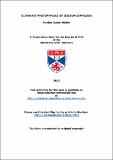Ultrafast photophysics of iridium complexes
Abstract
This thesis presents ultrafast photophysical measurements on a number of
phosphorescent iridium complexes and establishes relationships between the
relaxation rates and the vibrational properties of the material.
When ultrafast luminescence is measured on the peak of the phosphorescence
spectrum and on its red-side, 230 fs and 3 ps decay time constants were observed
in all materials studied, and this was attributed to population redistribution
amongst the three electronic substates of the lowest triplet metal-ligand charge
transfer (MLCT) state.
The observation of luminescence at higher values of energy embodied ultrafast
dissipation of excess energy by intramolecular vibrational redistribution (IVR)
and it was found that the dissipation channels and rate of IVR could be modified
by chemical modification of the emitting molecule. This was tested in two ways.
Firstly by adding electronically inactive dendrons to the core, an increase in the
preference for dissipation of excess energy by IVR rather than by picosecond
cooling to the solvent molecules was found, but this did not change the rate of
IVR. The second method of testing was by fusing a phenyl moiety directly onto
the ligand, this both increased the rate of IVR and also the preference for
dissipation by it rather than by picosecond cooling.
Fluorescence was recorded in an iridium complex for the first time and a decay
time constant of 65 fs was found, thus allowing a direct observation of intersystem
crossing (ISC) to be made.
In a deep red emitting iridium complex internal conversion (IC) and ISC were
observed and the factors controlling their time constants deduced. IC was found to occur by dissipation of excess energy by IVR. The rate of IC was found to be
dependent on the amount of vibrational energy stored in the molecule, with IC fast
(< 45 fs) when < 0.6 eV of energy is stored and slower (~ 70 fs) when the value is
> 0.6 eV. The rate of ISC agreed with these findings, indicating that the very
process of ISC may be thought of as closely analogous to that of IC given the
strongly spin-mixed nature of the singlet and triplet MLCT states.
Type
Thesis, PhD Doctor of Philosophy
Collections
Items in the St Andrews Research Repository are protected by copyright, with all rights reserved, unless otherwise indicated.

